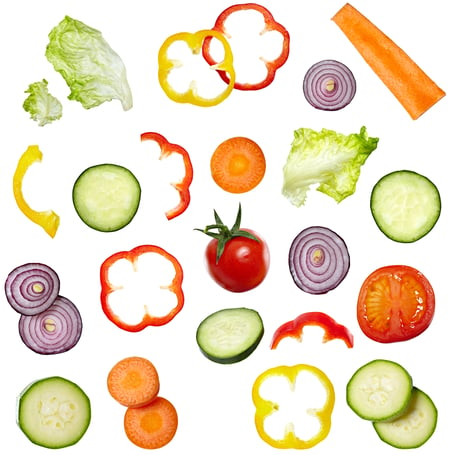
How can I use the Glycemic Index to help manage my prediabetes?
As you plan your meals, you will include starches and vegetables that contain carbohydrates. Carbohydrates are essential to normal body function and provide your body with its main source of energy! Pick your carbohydrate-rich foods based on their overall nutritional quality and how they will affect your blood sugar – especially if you have prediabetes.
Glycemic Index and Prediabetes Diagnosis
A prediabetes diagnosis can be alarming - this condition is marked by abnormally high blood sugar (glucose), most often caused by insulin resistance. Prediabetes is the term used to describe elevated blood sugar (glucose) that has not reached the threshold of type 2 diabetes diagnosis. The key is early intervention — to get your blood sugar out of the prediabetes range. Making a lifestyle change through diet and movement will always be the first line of treatment – so what you eat matters!
How the Glycemic Index Works
The Glycemic Index ranks foods on a scale of 0-100 depending on how fast the food will be digested, absorbed and converted into blood sugar. If you have prediabetes, it's important to maintain good blood sugar control. The key is to use the Glycemic Index to choose foods that will not cause a drastic blood sugar spike. Fiber-rich foods generally have a low glycemic index (GI), although not all foods with a low GI necessarily have high fiber content.
The lower the number, the lower the potential spike in your blood sugar levels. So, to keep your blood sugar from skyrocketing, choose foods that are categorized as "low" on the Glycemic Index. The ranking system is:
- 55 or less = Low (good)
- 56 - 69 = Medium
- 70 or higher = High ("bad")
However, the Glycemic Index of foods can change! So, foods that have a low GI are not always good and foods that have a high GI are not always off-limits. Sound confusing? Fear not; here are a few examples. Some factors that can affect the GI of food are:
- How you cook it: The GI of pasta, for example, can be significantly lowered by cooking it less (Al Dente)!
- How refined the carbohydrates are: Refined carbohydrates have most of their fiber removed, causing them to be digested and absorbed more quickly.
- The presence of fat, fiber, and acid: Fats, fiber and acid all help to slow the digestion of carbohydrates, prolonging the amount of time it takes for them to be converted to glucose in the body.
- How ripe the food is (this is especially important with fruit): The more ripe a food is, the higher the GI!
- Portion size: The more you eat of a carbohydrate-containing food at one time, the more your blood sugar will be affected.
When choosing foods based on the Glycemic Index, remember these factors to ensure your blood sugar will respond as planned! Eating a well-balanced diet, portion control and being aware of foods with high/low glycemic index are all ways to help you better manage a healthy lifestyle with prediabetes – and prevent type 2 diabetes. If you're interested in learning more and taking control of your health, talk to one of our registered dietitians.
Interested in a total overhaul to better manage your prediabetes? Check out our comprehensive prediabetes diet recommendations.
Below is our comprehensive list of where foods rank on the Glycemic Index
If you are interested in trying a low Glycemic Index approach, it may be helpful to try growing some of your own fruits and vegetables. Check out a few helpful tips and tricks for growing your own garden here.
Vegetables |
||
|
Low Glycemic Index (0-55) |
Moderate Glycemic Index (56-69) |
High Glycemic Index (70+) |
|
Asparagus Cabbage Mushrooms Tomatoes Cauliflower Broccoli Eggplant Raw carrots Lettuce Green beans Peppers Onions |
Beetroot
|
Pumpkin Parsnips |
Fruits |
||
|
Low Glycemic Index (0-55) |
Moderate Glycemic Index (56-69) |
High Glycemic Index (70+) |
|
Cherries Plums Grapefruit Peaches Apples Pears Dried Apricots Grapes Coconut Kiwi Oranges Strawberries Prunes |
Mango Bananas Raisins Papaya Figs Pineapple
|
Watermelon Dates |
Dairy |
||
|
Low Glycemic Index (0-55) |
Moderate Glycemic Index (56-69) |
High Glycemic Index (70+) |
|
Whole milk Skim milk Chocolate milk Soy milk |
Ice cream |
|
Beans/Legumes |
||
|
Low Glycemic Index (0-55) |
Moderate Glycemic Index (56-69) |
High Glycemic Index (70+) |
|
Kidney beans Butter beans Chickpeas Navy beans Red & green lentils Pinto beans Black eyed peas Split peas |
|
|
Starches |
||
|
Low Glycemic Index (0-55) |
Moderate Glycemic Index (56-69) |
High Glycemic Index (70+) |
|
Spelt bread Sour dough bread Whole grain tortilla All bran cereal Steel cut oats Barley Bulgur Pasta (Al Dente) Quinoa Peas Popcorn Sweet potato Squash
|
Flaxseed bread Pita bread Pumpernickel bread Roti Pumpernickel bread Rye bread Instant/quick cooking oats Basmati rice Brown rice Cornmeal Couscous Rice noodles White rice Wild rice Corn Parsnips Rye crackers
|
White bread Whole wheat bread Naan bread Corn flakes Cream of wheat Rice Krispies Special K Jasmine rice Sticky rice White rice Carrots Potato Pretzels Rice cakes Soda Crackers |
Interested in a total overhaul to better manage your prediabetes? Check out our comprehensive prediabetes diet recommendations.

Kaitlyn Willwerth is a Registered Dietitian at OnPoint Nutrition. Kaitlyn's work focuses on providing individualized health and lifestyle coaching and, most importantly, support. She is a Certified LEAP Therapist and has also completed the Monash University 'Low FODMAP Diet for IBS' online training course for health professionals.





